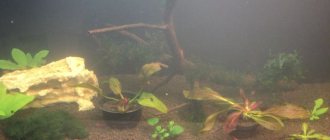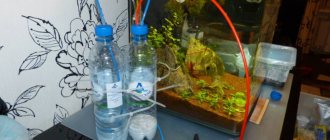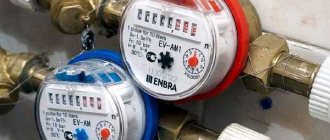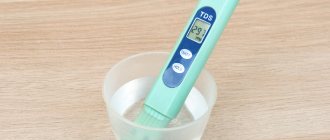During the summer months, overheating of water becomes a pressing and challenging problem for aquarium hobbyists. Fortunately, there are many simple ways to lower the water temperature in your aquarium in the short term. Most tropical aquarium fish live at a temperature of about 24-26 ° C, give or take a couple of degrees in one direction or another. But, in our climate, summers can be very hot, and often the temperature rises above 30 degrees, and this is too much even for tropical fish. At high temperatures, the amount of oxygen in the water rapidly decreases, and it becomes difficult for the fish to breathe. In severe cases, this leads to severe stress, illness and even death of the fish.
Ice bottles
The most popular and easiest way to lower the water temperature is to use a couple of plastic bottles with ice. This is almost as effective as putting ice in a filter, but is more spread out over time and smoother.
Still, it is important to ensure that the water does not get too cold, as this will lead to stress in the fish. Do not put ice directly into the aquarium, it will melt very quickly, it is difficult to control, and there may be harmful substances in the tap water.
These simple methods will help you and your fish survive the summer heat without loss. But it’s better to prepare in advance and at least put a couple of bottles of water in the freezer. Maybe they'll come in handy.
How to cool water in an aquarium
You can lower the temperature in an artificial reservoir using many methods; your own preferences and capabilities will help you choose which one. Some owners choose to cool their aquarium themselves by creating homemade coolers, while others purchase an aquarium cooler. In any case, regardless of the chosen method, every aquarist should have a water monitoring station. This is a set of instruments with which tank owners monitor water parameters:
- acidity;
- rigidity;
- amount of precipitation;
- temperature.
Thus, aquarists can always find out the exact number of degrees, and start taking action based on the results.
Water cooling methods:
- lowering the indoor air temperature;
- aquarium cooler;
- cooler or ventilation;
- homemade products for cooling.
High-tech methods
It is best, of course, to use modern technologies, although there are proven, simple and inexpensive methods. Modern ones include special stations for monitoring the parameters in the aquarium, which, among other things, can cool water and cool it.
Their disadvantages include the price and they are not so easy to buy; most likely you will have to order from abroad. There are also coolers and special items that are designed to cool the aquarium, but again they are not cheap.
One of the available methods is to place several coolers (fans from a computer in a simple way) in the lid along with lamps. This is often done by aquarists who install powerful lamps so that the surface of the water does not overheat. This works quite well, since in addition to air cooling, vibrations of the water surface also occur, increasing gas exchange.
The disadvantage is that there is not always time to assemble and install such a thing. You can do it easier if you have a fan at home, direct the air flow to the surface of the water. Fast, simple, effective.
What is overheating and why is it dangerous?
Aquarium fish are cold-blooded creatures that are unable to independently monitor their body temperature. Many phenotypes can only exist at a certain number of degrees of heat, and sometimes even minor deviations can lead to the death of pets. In hot weather, the risk of fish overheating is especially possible, which experienced aquarists determine by the behavior of their pets:
- the inhabitants of the reservoir become lethargic, move little or lie on the bottom;
- the fish move to the upper layers of the tank;
- pets constantly swim to the surface, swallowing air.
If such behavior is observed in fish in the summer, then most likely the temperature of the aquarium water does not meet the requirements of the phenotypes. In this case, you must immediately take auxiliary means, and then start lowering the degrees. First aid for overheating consists of the following:
- The lights in the tank are turned off, as some lighting fixtures heat up the water too much.
- Remove the lid from the aquarium (if there is one). In order not to worry about moving and active pets that might jump out, you can cover the tank with light fabric or mesh.
- The compressor power is increased to maximum to create air circulation.
It should be noted that some novice aquarists, when faced with the question of how to cool an aquarium for the first time, throw ice cubes into the liquid or replace part of the liquid with cold water in an attempt to change the temperature. Under no circumstances should this be done! Such a sharp change in degrees can lead to the death of pets.
Changing filter characteristics
Heating affects the volume of air present in the liquid. Its numbers decrease on especially hot days.
Internal filtration units are located near the surface so that the liquid in the tank is cooled. If the aquarist has an external filter, then it should be equipped with a flute tube. With its help, water reaches the surface, improving aeration rates.
This makes it easier to cool small containers containing representatives of flora and fauna. In this case, it is necessary to control temperature indicators using appropriate devices.
How to increase the temperature
The life of the inhabitants of the aquarium depends on normal temperature. Typically, owners use special immersion heaters. They are sold in pet stores.
When choosing, take into account the dimensions of the tank so that the device lowers to the desired level. Pay attention to tightness and power (per 100 l - 100 kW or more). The desired temperature is set on top of the heater. They check it with a thermometer; often the device does not guarantee accurate readings. Or they purchase a separate thermostat with a digital display, thus using double protection.
There are also devices that are installed underground for heating and outside. If the thermometer drops, take the following measures:
- Lean a heating pad against the wall.
- Move the aquarium towards a heat source.
- Lower the hot water bottle.
- Use an air conditioner, setting it to warm or a regular hairdryer.
- Install an incandescent lamp nearby.
- Immerse the external filter in warm water (not hot).
- Add 30 ml per 100 liters of vodka, cognac (in emergency cases).
- Carefully pour water from the kettle, not very hot.
At the same time, close the doors and windows so that there is no draft; hot water cannot be poured into the tank. It happens that it is necessary to increase the temperature to treat fish and reproduce
Favorable regimes for various types of fish in the table
The inhabitants of a home aquarium come from different places and their contents are slightly different:
| Name | Comfortable temperature | Maximum | Minimum |
| Guppy | +23…+26 °С | +32 °С | +11 °С |
| Angelfish | +24…+27 °С | +33 °С | +19 °С |
| Gourami | +22…+27 °С | +33 °С | +20 °С |
| Danio | +21…+24 °С | +31 °С | +15 °С |
| Cockerels | +23…+25 °С | +29 °С | +19 °С |
| Mollies | +25…+27 °С | +34 °С | +22 °С |
| Swordtails | +22…+25 °С | +29 °С | +15 °С |
| Neons | +23…+25 °С | +29 °С | + 17 °C |
| African cichlids | +22…+24 °С | +30 °С | +20 °С |
| Tropical cichlids | +25…+28 °С | +33 °С | + 22 °C |
| Barbs | +20…+25 °С | +30 °С | + 15 °C |
| Goldfish | +20…+24 °С | +27 °С | +16 °С |
| Pterygoplichts (large catfish) | +25…+28 °С | +29 °С | +19 °С |
| Parrotfish | +21…+24 °С | +25 °С | +18 °С |
| Ancistrus | +22…+26 °С | +27 °С | + 21°C |
| Aquatic turtles, such as red-eared turtles | +24…+29 °С | +34 °С | +21 °С |
| Agamixis (catfish species) | +26…+27 °С | +32 °С | +23 °С |
| Gambusia | +20…+24 °С | + 35 °C | +12 °С |
| Astronotus | +21…+28 °С | +30 °С | +16 °С |
The optimal temperature can be raised during spawning; a constantly high temperature usually helps to shorten the life of the fish.
What tropical fish can be kept in cold water?
Although some tropical fish, such as corydoras and cardinals, even prefer cool water, it is too stressful for most.
The analogy is simple, we can also live for quite a long time on the street and sleep in the open air, but in the end everything will end sadly for us, we will at least get sick.
Optimal temperature for different species and groups
For comfortable existence, development and reproduction of fish, a certain temperature regime of the aquatic environment in the aquarium is necessary. This is one of the main indicators that must be constantly monitored and maintained.
The course of chemical reactions, physical and physiological processes of the inhabitants of the aquarium depends on the temperature of the water.
For barbs
Barbs can be found in many countries in Europe, Asia and Africa. These fish are unpretentious and undemanding. They can thrive in both cold and warm waters. Barbs are easy to feed, breed and maintain optimal conditions for their existence.
The recommended temperature is from 20 to 27 degrees, the minimum is 15, the maximum is 30. It is desirable that the water is well aerated and has a slight current. They can be kept in any aquarium.
For guppy
In nature, guppies live in freshwater and slightly salty waters around the world. To grow beautiful and healthy fish, it is necessary to provide them with space and constant aeration of the water.
The optimal temperature is 23-26 degrees, the minimum is 14, the maximum is 32.
If guppies are kept in cool water, they grow larger, but the risk of getting sick increases.
For angelfish
Angelfish can only be found in warm tropical waters.
The norm for their existence should be within 24-27 degrees, the minimum is 19, the maximum is 33 degrees.
In warm aquariums, angelfish's immunity increases, they grow faster and begin to reproduce. But a too warm environment reduces their lifespan.
For neons
They live in the tropics of South America, preferring warm waters with a slight current.
The best temperature for keeping neons is 23-25, the minimum is 17, the maximum is 29 degrees.
Living in a body of water that is too warm dramatically reduces the lifespan of neons. If at 21 degrees neon can live up to 4 years, then at 27 it can live no more than 18 months.
For swordsmen
Under natural conditions, swordtails live in the waters of Central America, where the average temperature is 22-25 degrees. For some time, the swordtail can exist in a cool body of water up to 15 degrees. The maximum thermometer reading for the swordtail is 29 degrees above zero.
For American cichlids
There are two types:
- inhabitants of the warm waters of South America;
- inhabitants of the warm waters of Central America.
Tropical cichlids can only live in very warm waters.
The water temperature for cichlids in the aquarium is 25-28 degrees. Even at 22 degrees they can hardly exist. The upper threshold of the thermometer is 33 degrees.
Cichlids from Central America feel great in a reservoir with 21-24 degrees. They can easily live in a cool water environment of 13-15 degrees, maximum temperature is 28.
For African cichlids
Under natural conditions, they live in warm rivers, where the water can cool to 20 or heat up to 30 degrees.
The optimal temperature for keeping African cichlids is 22-24 degrees.
For Malawian cichlids
Under natural conditions they live in lakes at 24-26 degrees. This is the optimal indicator for the existence of cichlids from Lake Malawi.
You can lower the temperature to 20 and raise it to 30 degrees only for a short period of time (no more than 5-6 hours). Cichlids tolerate cool water more easily than warm water.
For cockerels
There are no cockerels in nature. They were developed through selective breeding.
The recommended temperature for cockerels is 23-25 degrees. Minimum - 19, maximum - 29.
If you keep your bettas in an aquarium with cool water all the time, they will get sick.
For zebrafish
In nature, zebrafish live in rivers and streams in southeastern Asia. The norm for their maintenance is 21-24 degrees, to stimulate its dilution it is increased to 28-29. Minimum - 15, maximum - 31 degrees.
For parrot fish
Unpretentious parrot fish can be kept in a reservoir with 21-25 degrees. Temperatures below 18 can have a negative impact on the health of the fish.
As non-tropical fish, parrots are advised to be kept in a warm environment.
For gourami
Gourami live in southeast Asia, mainly in fresh and slow-moving waters.
The optimal water environment is 22-27 degrees. A decrease to 20 and an increase to 33 degrees is possible.
When kept in cold waters for a long time, gouramis die. Even at 20 degrees they can only be kept for a few hours.
For mollies
Mollies are heat-loving inhabitants of the waters of South America.
Ideal temperature indicators are 25-27 degrees. You can lower it to 22, but not for long. The maximum should not exceed 34 degrees plus.
In nature, mollies are accustomed to living in a very warm aquatic environment; when it cools, they often develop fungal infections.
For goldfish
These are non-tropical fish that live in temperate zones, in fairly cool water.
The temperature norm for all types of goldfish is 20-24, minimum - 15, maximum - 27.
In ancient times, goldfish were kept in outdoor pools.
For catfish and catfish
More than 1,000 species of fish from different families are called catfish, so it is not easy to determine a single temperature indicator. Typically, catfish can live at a temperature closer to room temperature, 22-25 degrees. To stimulate reproduction, increase it by 2-3 degrees.
Different types of catfish live in different regions of the planet:
- Pterygoplichts are inhabitants of the tropics. The optimal temperature environment is 25-28 degrees, you can briefly lower it to 22, raise it to 30;
- Agamixis - live in warm water. The optimal temperature environment is 26-27, minimum - 23, maximum - 32;
- Bunocephalians are small predators. In nature, they live in the reservoirs of Central America, preferring cool temperatures; the ideal thermometer reading is 21-23 degrees;
- Synodontis is a family of catfish that can live at room temperature. Optimal - 21-25, minimum - 19, maximum - 29.
For crabs and shrimp
Most shrimp kept in aquariums come from Asia. These are hardy creatures. All types of aquarium shrimp are not picky about their housing conditions. The ideal temperature for keeping is 24-25 degrees, the minimum is 15, the maximum is 30. If the temperature in the apartment is not lower than 17 degrees, then you can keep shrimp without heating.
Crabs are quarrelsome arthropods that cannot tolerate their neighbors, even their own relatives. They live mainly in salt water, but there are also freshwater species that take root at home.
Types of crabs:
- rainbow - grows up to 15 cm;
- leopard - a freshwater creature, aggressive, kept only in pairs (female + male);
- mango - unpretentious, 4.5 cm;
- freshwater Dutch - 2-3 cm, omnivorous and peaceful.
The temperature norm for crab is 22-26 degrees. Failure to comply with these parameters can lead to the death of arthropods.
For aquatic turtles
Usually tropical species live in aquariums, but currently the red-eared turtle species is popular. It is a heat-loving creature that cannot tolerate cool temperatures.
The optimal thermometer reading is 24-29 degrees. For a short time you can lower it to 21, the maximum is 34 degrees.
Temperature control methods
Having found out what temperature is comfortable for the fish species living in the aquarium, all that remains is to control it. Various devices are used as control devices:
- Glass coated thermometer. Provides accurate readings, is easy to use, and inexpensive. The only negative is that if the device breaks, toxic mercury will get into the water and the fish will be poisoned.
- Adhesive indicator strip. Easy to use, simply sticks to the surface of the tank. The downside is the lack of accuracy of the indicators.
- Thermometer with alcohol filler. Convenient and inexpensive option. But gradually the reliability of the indicators decreases.
- Electronic thermometer. Provides the most accurate indicators. But it's expensive.
Why is the right water temperature so important?
Pisces are cold-blooded creatures. If the thermometer reading is normal, the fish do not get sick and do not suffer from metabolic disorders.
If the water is colder than necessary, all processes in the body slow down, immunity sharply decreases, fish become inactive and are easily susceptible to any infections.
Too warm water also has negative effects on fish. With increased water heating, metabolism accelerates, fish become restless, begin to consume a lot of oxygen and experience a lack of it. In such cases, they swim to the surface and convulsively swallow ordinary air. Death often occurs due to lack of oxygen.
How sensitive are fish to temperature?
Aquarium inhabitants are sensitive to the slightest changes in temperature. For most ornamental fish, the normal temperature in the aquarium is from 22 to 26 degrees, but there are exceptions. Labyrinth fish and discus prefer warm water environments.
Aquarium fish (mostly all tropical species) are accustomed to being in warm bodies of water, with a constant, stable temperature. Temperature fluctuations do not exist in natural habitats because large bodies of water cool and warm up slowly. Therefore, fish are not adapted to sudden changes. Temperature changes often occur in small aquariums - less than 50 liters. Such small bodies of water are very sensitive to environmental temperature changes; they quickly cool and heat up.
With a sharp change in temperature, they can become extremely stressed and develop infectious diseases due to weakened immunity. There may also be deaths.
The reason for the change in temperature in the aquarium can be an open window during the cold season. Pisces may catch a cold and need special treatment.
Fish that live in our climate are more resistant to change. For example, goldfish can live in reservoirs with a water temperature of 5 degrees and at a temperature of more than 30 degrees. But at high temperatures, various skin diseases can develop.
It should be remembered that even with a difference of 3-4 degrees, the fish begin to develop a state of shock, which often leads to fatal consequences. There are cases when newly acquired fish die.
In order for fish to adapt, they must first be acclimatized. It should be remembered that the higher the water temperature, the faster the fish grow, age and die.
What to do if there are temperature changes?
Fish most often suffer from sudden temperature fluctuations when transported from a pet store to a new home. Usually, owners transport purchased pets in a small jar or bag. In summer, fish can die due to heat and stuffiness, in winter due to the sharp cold outside the store.
To prevent illness and death of pets from temperature changes, it is recommended to transport them in a thermos. If a large thermos is not at hand, then the purchase should be made at a pet store close to your home so that the fish’s journey does not take much time.
Beginning aquarists should not only find out the preferred temperature for each type of fish, but also purchase heating and cooling equipment in order to act quickly in a critical situation. In unfavorable temperature conditions, fish are stressed, get sick, live short lives, but in favorable temperature conditions they delight with their beauty for a long time.
Decrease of indoor air
This is the simplest and easiest way to cool the water in an aquarium with your own hands. It's no secret that the temperature of the liquid directly depends on the air temperature in the room, so you shouldn't be surprised when aquarium water is heated in the summer heat. You can reduce the amount of heat by closing the curtains on the windows tightly so that the sun's rays do not penetrate into the room. Air conditioners and home fans are also used to ventilate the room.
Aquarium cooling equipment
If the methods listed above do not work well enough, it may be time to install additional hardware.
- Install multiple fans. Installing one or more small (or large, depending on the size of your tank) fan to blow air across the surface of the tank can really help with evaporation and prevent your tubes from overheating. You may have trouble finding them at your local pet/aquarium store, but attached fan systems are available online.
- Install the chiller. If all the above steps don't work for you, you may need to install a chiller. These systems typically aren't cheap, but if you have a larger tank with a precious supply, like a reef aquarium, display quality goldfish or imported fish, it's definitely better to be safe than sorry. Finding chillers at a regular aquarium store can be a little difficult, but they are available online.
If you've ever overheated an aquarium, you know how disastrous it can be. I personally know many, many aquarists who have lost precious fish over the summer, so I really want to encourage everyone to keep a close eye on that thermometer! Don't wait too long to take precautions; Maintain a stable and safe temperature and be sure to run the bubbler to agitate the surface.
Water cooling with coolers and fans
Water cooling with coolers is based on the principle of water evaporation and temperature reduction. These cooling systems are usually homemade.
1 or 2 fans are installed in the lid of the aquarium (usually those used in a computer and installed on the case, power supply or processor). These fans are low voltage (rated at 12 volts) so moisture and steam are not a danger. The fans are connected to a 12-volt power supply (the power supply is sensitive to steam and moisture, so to avoid electric shock, it should never be installed in the lid of the aquarium or near water).
Fans circulate air under the lid of the aquarium, thereby increasing evaporation and cooling the water.
As a rule, if one fan is used, it is installed to pump air, and additional holes are made in the cover for exit.
When using two fans: one is installed for air injection and the other for air exhaust.
The fan cooling system is very effective and can cool the aquarium to a safe temperature for the fish even on the hottest days, but it has two significant disadvantages:
- In a room with an aquarium, a greenhouse effect may occur due to a strong increase in air humidity.
- Increased evaporation of water will require constant topping up.
Decrease in temperature level
Filter upgrade
For an aquarium, you create a cooling system using a filter with your own hands. This option is suitable if the tank is equipped with an internal filter. A washcloth is removed from this system, with the help of which the liquid is cleaned. Ice is placed in place of the washcloth.
With this homemade product, the aquarium liquid cools in 5–10 minutes. But before using such a system, experts recommend purchasing a temperature tracking device. After all, excessively cold water will provoke the death of fish and shellfish phenotypes.
Container with ice
Fill 1-2 bottles with ice. They are placed in a container with fish and shellfish. This method is similar to the one described earlier. But at the same time, the liquid in the aquarium cools gradually. The temperature level is constantly monitored to prevent hypothermia. For these purposes, a controller or other component is suitable, with the help of which it is easy to regulate the temperature level in the tank.
Cooling system with Peltier elements
Experienced aquarists prepare cooling systems for their aquariums with their own hands, which include a Peltier element. To construct such a system, the following components are used:
- Coolers from old computers. Such parts contribute to noise. Among modern installations it is easy to find parts with which ventilation is performed almost silently.
- Peltier element. The system is constructed on 2 elements. Their power is determined individually. In this case, the dimensions of the tank, its equipment, and phenotypes are taken into account.
- Radiators. They are used to remove generated heat.
- Cooling water block. Each Peltier element is placed in it.
- Thermal controller. The temperature level is regulated using a thermal controller.
- A power supply whose output voltage is 12 Volts.
- Water pump. Experienced aquarists install pumps in advance. If such a device is not available, it must be purchased separately. The performance of such a device is determined individually. Such points as the size of the aquarium and climatic features are taken into account.
The system, which includes a Peltier element, is used by beginners and experienced aquarists to cool liquids. For what reason is it popular?
- With the help of such a refrigeration system, the temperature is reduced to the required level. Suitable components and devices are used for continuous monitoring.
- Autonomy. Before using such a system, you should monitor its performance for 2-3 hours.
- Low energy consumption.
- Efficient coolers.
- Optimal dimensions.
Before choosing a method by which the liquid in the aquarium will be cooled, you should study the features of each. For small containers, a filter filled with ice or a cooler is suitable. For larger tanks, cooling systems that are equipped with adjustment elements will be required.
Video about different ways to cool small and large aquariums
AdminAuthor of the article
Did you like the article?
Share with your friends:
Emergency measures
Various unpleasant moments happen in life that can lead to overheating or hypothermia of the aqua world. The correct ways to eliminate these situations will help restore the balance of the reservoir and preserve the health and life of aquatic inhabitants.
Temperature drop
A failed temperature sensor on the heating pad or close proximity to the heating system can cause a sharp increase in the aquarium. If the pond is located on a windowsill, in the summer it can be heated by the sun's rays. It is necessary to ensure that the parameters do not exceed 30 degrees, otherwise the fish in it may cook.
What actions are needed to lower the temperature:
- you need to fill a plastic bottle with water or ice; you need to lower it smoothly;
- keep the compressor or fan constantly on until it drops to normal; increased aeration will help the fish breathe;
- you need to enrich the water with oxygen using 1 tbsp. l. hydrogen peroxide (per 100-liter container); this drug will disinfect the reservoir and destroy parasites;
- Cool the room and pond using an air conditioner (if available).
It should be remembered that increasing the temperature is more contraindicated for aquarium fish than decreasing it. The poor health of the fish may be due to the presence of various nitrates in the reservoir, which are especially harmful when the thermometer is elevated.
Heat
A cool environment inhibits metabolic processes in the fish’s body. This can lead to immobility, lethargy and decreased defenses against any infection.
The temperature of the reservoir may drop as a result of simply ventilating the room and the fish will become ill. The owner of the aquarium may not immediately notice that the health of the aquatic inhabitants has worsened. This problem can be eliminated by heating.
What needs to be done to raise the temperature to standard levels:
- you need to connect a heating pad, connect it and heat the water to the required parameters;
- you can add a little boiled water to the reservoir (no more than 10% of the total volume); you need to pour water gradually, adding heat no more than 2 degrees every 20 minutes; during the procedure, make sure that hot water does not get on any fish;
- for the heating procedure, you can fill a plastic bottle with boiling water and lower it into the aquarium for a couple of hours; it will give off heat to the aquarium water;
- if the fish are feeling really bad, add cognac or vodka to the pond; 1 tbsp is enough for 100 liters of water. l. alcohol; this will invigorate them, but soon the container will need to be rinsed;
- There is another way, but it is dangerous: using incandescent lamps for heating; If possible, it is better not to take risks.
Cooling water with chillers
Chillers began to be produced relatively recently. They are refrigerators for aquarium water. Original aquarium air conditioners. You will have to pay several hundred American dollars for a chiller, so not all aquarists are able to fork out for such “happiness”. And purchasing it for a small aquarium with a small number of fish is extremely unprofitable.
But it is perfect for cooling large aquariums with a wide variety of living creatures and beautiful plants. A fully automatic device will maintain the set water temperature, regardless of how hot it is “overboard”.
Chillers do not have such disadvantages as increased humidity in the room associated with their operation. They are quite quiet and efficient. The only disadvantage of aquarium chillers is the price!
In general, I hope the article helped you figure out what to do if, according to weather forecasters, it will soon be extremely hot and you are worried about your aquarium animals.
Fish that can withstand extreme conditions
When buying an aquarium and selecting fish, you should take into account that some individuals need relatively cool water, others need warmer water. First you need to make sure that they can live together at the same temperature.
The hardiest fish are cichlids. They can live in warm and cool water, but at average temperatures.
It should be remembered that for heat-loving fish, a strong drop below 18-20 degrees is unacceptable, and for cold-resistant fish, a body of water that is too warm. The maximum is 21-24 degrees.
Cold-resistant
The body temperature of fish depends on the environment. Only a few fish (some catfish) can change its body parameters. The sharks also keep her body score several degrees higher than the water. Corydoras and cardinals also like cool water.
In addition, goldfish and neons can exist for a long time at low temperatures. Therefore, they can be kept in aquariums without heating, but in such conditions there must be good aeration and sufficient space for normal existence.
Heat-loving
Among aquarium fish there are heat-loving varieties that require a temperature of 27-29 degrees for comfort. It is ideal for discus, angelfish and other types of tropical fish that live in waters of South America with year-round temperatures of 25-28 degrees.











